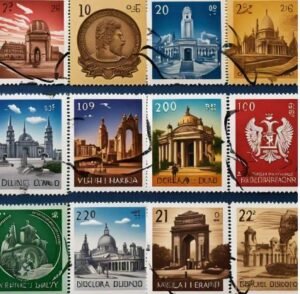Stamp collecting, or philately, is not just about amassing beautiful stamps; it’s about understanding the rich history and significance behind each piece. Among the many categories of stamps, two of the most notable types are commemorative stamps and definitive stamps. Both have unique histories and purposes, but they also serve different roles within the world of philately. In this article, we will be exploring commemorative vs. definitive stamps, diving into their rich history, and uncovering the key differences between them. We will also help you avoid getting bogged down in the minutiae, so you can appreciate each stamp for its historical and artistic value.

What Are Commemorative Stamps?
Commemorative stamps are issued by postal authorities to mark significant events, anniversaries, or cultural milestones. These stamps are usually part of a special issue, often released in limited quantities, and feature unique designs to commemorate the event or subject at hand. Whether it’s a historical milestone, the birth of a famous person, or a major national event, commemorative stamps capture the spirit of the moment and preserve it for posterity.
When exploring commemorative vs. definitive stamps, you’ll find that commemoratives tend to be more colorful, artistic, and detailed, with designs that reflect the theme or subject. For example, a stamp commemorating the 100th anniversary of a country’s independence might feature national symbols, historic landmarks, or images of prominent leaders.
Key Features of Commemorative Stamps:
- Special Issues: These stamps are usually issued in limited numbers and are often part of a specific series.
- Designs: They typically have elaborate, eye-catching designs that represent the theme of the stamp.
- Higher Value: Due to their limited edition nature and specific commemorative theme, these stamps can be more valuable than their definitive counterparts, particularly in mint condition.
- Shorter Lifespan: Commemorative stamps are usually issued for a specific period—sometimes only for the duration of an event or celebration—before they are discontinued.
What Are Definitive Stamps?
In contrast, definitive stamps are the everyday postage stamps that are used for routine mail. These stamps are issued in larger quantities and remain in circulation for a long time—sometimes for several years. Their purpose is simple: they represent the face value of postage needed to send letters, parcels, and other forms of mail.
When exploring commemorative vs. definitive stamps, definitive stamps are often more straightforward in design. They typically feature national symbols, portraits of significant figures, or images of everyday objects. Unlike commemorative stamps, definitive stamps are not tied to special events but rather serve a practical function in the postal system.

Key Features of Definitive Stamps:
- Standard Issue: These stamps are issued in large quantities and remain in use for a long time, often without any significant design changes.
- Simple Designs: They usually feature iconic images like national landmarks, heads of state, or generic symbols, often in muted colors.
- Longer Lifespan: Definitive stamps can remain in circulation for years or even decades.
- Widespread Use: As they are used for regular mail, definitive stamps are often less valuable than commemorative stamps, unless they are rare or feature unique variations.
Exploring Commemorative vs. Definitive Stamps: Key Differences
Now that we’ve defined commemorative stamps and definitive stamps, let’s take a closer look at the key differences between them. By understanding these distinctions, collectors can gain a deeper appreciation for the role each type plays in philately.
Purpose and Usage
- Commemorative Stamps: Primarily issued to celebrate or commemorate a specific event, person, or historical milestone. They are meant to capture a moment in time and are often seen as more valuable due to their special edition status.
- Definitive Stamps: Issued for routine, everyday mail use. Their design is typically more functional, as their purpose is to serve as postal currency rather than to mark a special occasion.
Design and Aesthetics
- Commemorative Stamps: These stamps feature more intricate and artistic designs. They often have vibrant colors, detailed imagery, and creative themes to match the occasion they represent.
- Definitive Stamps: The design of definitive stamps is generally simpler and more utilitarian. They tend to feature standard symbols like national flags, portraits of leaders, or national landmarks.
Rarity and Value
- Commemorative Stamps: Due to their limited runs, commemorative stamps can be rarer and more valuable, especially in mint conditions. Some rare commemorative stamps have sold for thousands, if not millions, of dollars.
- Definitive Stamps: Because they are produced in large quantities and are used for regular postal service, definitive stamps are generally more abundant and less expensive, though certain variations or errors can still command high prices.
Lifespan
- Commemorative Stamps: Issued for a limited time to commemorate a specific event or occasion. Once the event has passed, these stamps are often withdrawn from circulation, making them a collector’s item.
- Definitive Stamps: These stamps are available for long periods and are continuously reissued in different denominations to meet regular postal demands.

Dive Into the Rich History of Commemorative and Definitive Stamps
Both commemorative stamps and definitive stamps have rich histories tied to the countries that issue them. The stories behind these stamps provide a unique window into the history, culture, and values of the issuing nation. As you delve deeper into exploring commemorative vs. definitive stamps, you’ll find that each stamp has its own narrative—whether it’s about the artist who designed it, the event it commemorates, or the political climate that shaped its creation.
For example, stamps commemorating the 1969 Apollo Moon landing are a testament to human achievement, and their historical significance makes them highly sought after by collectors. On the other hand, definitive stamps featuring images of prominent political leaders, such as Queen Elizabeth II on British stamps, reflect the continuity and stability of a nation.
Understanding the history of these stamps can also enhance your collecting strategy. By learning about the political, social, and cultural events that prompted the release of commemorative stamps, you can make more informed decisions about which stamps to collect. While definitive stamps may be used more frequently and widely, commemoratives often hold higher long-term value, especially if they represent a unique moment in history.
Don’t Get Stuck in the Details
While it’s tempting to dive into the minute details of each stamp’s printing process, color variations, and production errors, it’s important to keep the bigger picture in mind when exploring commemorative vs. definitive stamps. Getting caught up in every tiny detail might cause you to miss the broader historical significance that makes stamp collecting so rewarding.
Here are some tips to avoid getting lost in the weeds:
- Focus on the Story: Remember that each stamp tells a story. Whether it’s commemorating a royal event, a historic anniversary, or a national tragedy, try to connect with the larger narrative.
- Know Your Goals: Determine if you want to build a collection based on rarity, historical importance, or aesthetic beauty. Focusing on your personal collecting goals will help you avoid distractions and unnecessary details.
- Don’t Overcomplicate: Collecting stamps should be fun! While research and knowledge are crucial, don’t overwhelm yourself with every single printing variation or minor error—unless that’s your specific collecting interest.
Conclusion
In conclusion, exploring commemorative vs. definitive stamps opens up a fascinating world of historical and cultural exploration. By understanding the differences between these two types of stamps, collectors can make more informed decisions about their collections, find valuable pieces, and connect with the history behind each stamp. Remember, while the details are important, don’t get stuck in them—keep your focus on the rich history and the stories these stamps tell. Whether you choose to collect commemorative stamps, definitive stamps, or both, your collection will reflect the rich tapestry of human history, and that’s what makes stamp collecting so rewarding.



